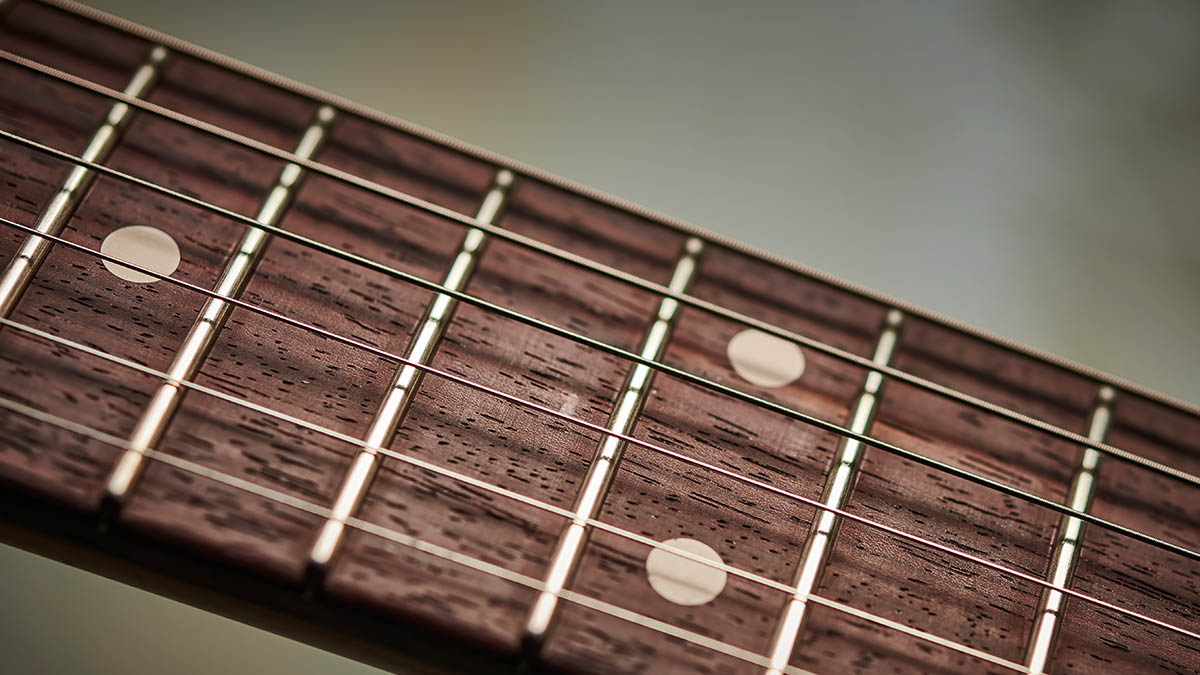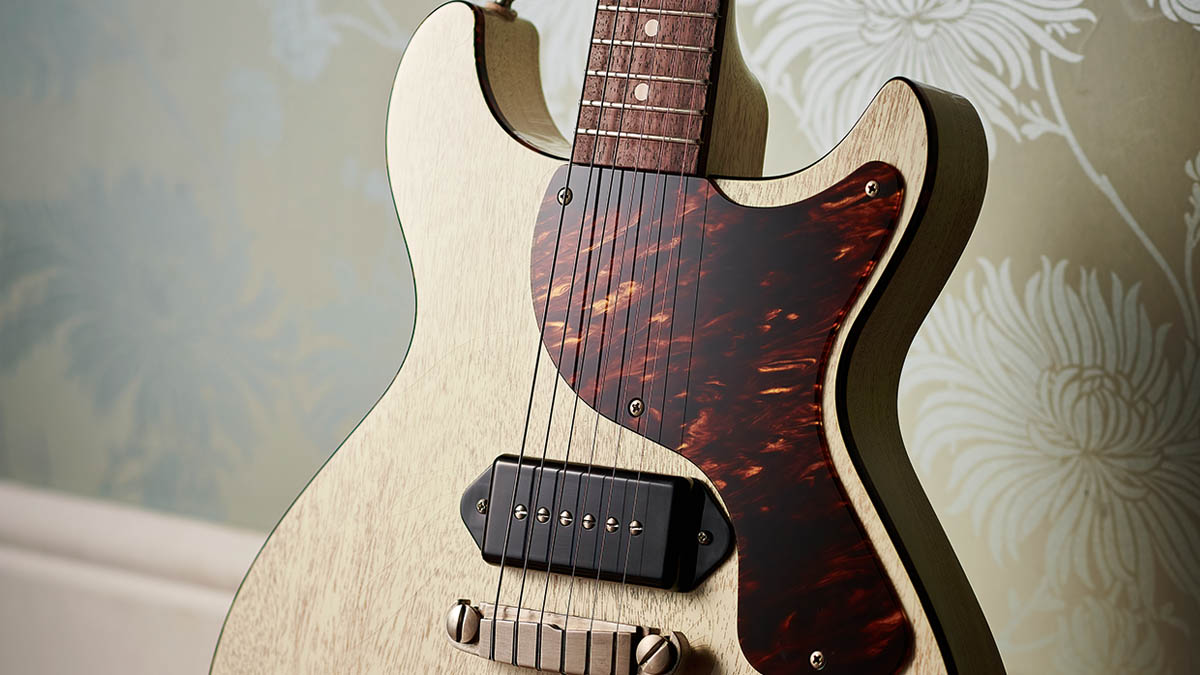Guitar World Verdict
A perfect version of a classic that feels, sounds and plays to the highest level – we’d rate it 11/10…
Pros
- +
It is a rock 'n' roll machine, especially with 'blower' switch engaged.
- +
Lived-in feel.
- +
Hugely detailed build.
Cons
- -
But while you can’t fault the craft, it is a pretty close cousin of the hallowed double-cut Gibson.
You can trust Guitar World
Any reckoning of the UK’s guitar making industry has to include Patrick James Eggle, a fixture on the scene since the early 90s and now the perfect illustration of the artisan or boutique small-output maker.
Patrick, like many over these past months, has seen his orders rise, he’s taken on more staff, which now total seven, and produces some 20 guitars a month.
You don’t need us to tell you that this latest creation is inspired by Gibson’s double-cut Les Paul Junior, an electric guitar designed at the end of the 50s and one that refuses to die. In fact, its influence on guitar makers, large and small, seems to increase year-on-year. PJE also offers a single-cut Macon Junior (albeit with dual pickups), and with an added maple top it becomes a Special.

Our double-cut Junior, then, is the only ‘correct’ Junior in the Macon range with its single pickup referencing the basic student Gibson model from 1958. But there’s nothing ‘student’ about this guitar. If there were such a thing as Michelin stars for guitar makers, Pat would have a few. This is simply a superb version of a very classic recipe.
It doesn’t deconstruct or mess with the classic ingredients, either. Here, we have a one-piece slab body (45mm thick) from genuine mahogany, likewise the neck, topped with a dot-inlaid and unbound dark Indian rosewood fingerboard.
The light weight is perfect for the style and, unlike many of PJE’s builds, it’s unchambered like the carved-top Macon, for example, and there’s no maple cap, either. Aside from the inlaid headstock logo, the only bling is the body’s edge-binding from a rich and dark-coloured tortoiseshell celluloid nitrate plastic that mirrors the acrylic scratchplate.

The light dirty cream colouration of the Grained Blonde finish might make you question what the actual materials are, however – until you see the worn-through neck back, which has the finish removed and shows you what’s underneath.
All the latest guitar news, interviews, lessons, reviews, deals and more, direct to your inbox!
Look a little closer and you’ll see numerous cracks in the heat-aged nitro finish that otherwise has a healthy gloss sheen. It’s not a relic, although all the hardware is aged in-house. Not for the first time, this Eggle comes across as a very well cared for vintage guitar, and one that’s certainly been played in.
Remove that scratchplate and you’d expect to see the long tongue of the neck. Such is the quality of the craft you really have to look twice to see that the tongue is the full width of the neck and has a rounded end that extends some 80mm into the body – something you wouldn’t get if there were a neck pickup.
Feel & Sounds
Let’s be honest, as good as this build is it’s not really bringing much to the table in terms of new sounds or features. But, for many of us, that’s exactly the appeal. If you could find a real double-cutaway Junior that felt, played and sounded as good as this does, well, we’d doubt you’d snag it for this price. It’s absolutely superb and, like any high-line guitar, its sound should be totally absorbing. It is.
There’s no compromise here, just great vintage-informed craft
But to backtrack, it’s the worn-through neck, with its bare-wood feel, that feels stripped down and well used. The ‘C’ 60 profile might be a bit of a misnomer as, dimensionally, it’s just a couple of passes with glass-paper thinner than the Macon’s Fat 50 neck we reviewed last year: 22.5mm at the 1st fret and 24mm at the 12th, as opposed to 23.5mm/25.3mm of that earlier Macon.
Maybe it’s the relaxed shoulders, but the neck really does seem slimmer than the dimensions suggest. Then there are the well-rolled fingerboard edges and the highly polished frets (approximately 2.28mm wide and just under 1.4mm high) with perfectly domed ends. There’s no compromise here, just great vintage-informed craft.

How does it fare against our original ’57 single-cut Junior reference? Well, better than many. Single-cut Juniors might have the edge in terms of depth; the double-cuts typically sound a little leaner in the low-end, and that’s certainly what we hear here.
It’s not just the hugely detailed build but also the vintage-like played-in feel of the guitars that continues to impress us
Yet that almost focuses the midrange-y, raw-edged P-90/mahogany ‘grind’, a sound you’ve heard countless times. It’s not at the expense of high-end detail, which is crisp without being excessive.
The control circuit gets close to the original, and the vintage wiring gives a lot of subtlety for thinner and lighter voicings, although we might be tempted to use a lower-value cap as the roll-off here is a little excessive. But that’s only a consideration if you actually use the tone control.
Frankly, with the ‘blower’ switch engaged (the pickup goes directly to the output), this is one of the most visceral in-your-face Juniors we’ve played. Yes, it can do ‘subtle’, but when it’s as raw and raunchy as this, embrace it: the essence of rock ’n’ roll.

Verdict
To say Patrick and his small team have settled into their stride is an understatement. It’s not just the hugely detailed build but also the vintage-like played-in feel of the guitars that continues to impress us and many others. And with such a quality build these guitars never sound less than spectacular.
To some, of course, a guitar like this is simply a Gibson knock-off with the wrong name on the headstock, but it’s one of the best cover versions of that classic design we’ve played, turning the simple student model design into a thoroughly top-level tone machine. Seriously, plug one in and see what the fuss is about. Don’t blame us if you have to buy it, though….

Specs
- PRICE: £2,999 (inc case)
- ORIGIN: UK
- TYPE: Double-cutaway, set-neck solidbody electric
- BODY: 1-piece mahogany
- NECK: 1-piece mahogany, C-60 profile, glued-in
- SCALE LENGTH: 625.5mm (24.625”)
- NUT/WIDTH: Bone/43.15mm
- FINGERBOARD: Rosewood with ‘clay’ dot inlays; 305mm (12”) radius
- FRETS: 22, medium/tall Jescar 55090
- HARDWARE: Milled aluminium ABM 3025 intonated wrapover bridge/tailpiece, Gotoh SD90 vintage-style tuners with ‘keystone’ buttons –
aged nickel - STRING SPACING, BRIDGE: 52mm
- ELECTRICS: Mojo P90 Dogear single coil, master volume and tone controls (with direct out ‘blower’ switch)
- WEIGHT (kg/lb): 3.26/7.17
- OPTIONS: Base price is £2,900; our top binding adds £99. Options: 3A grade roasted maple figured neck (£80), master grade figured maple neck (£300), white pearloid pickguard (£50). Standard gloss nitro finish. Custom colours/metallics (add £140)
- RANGE OPTIONS: Single-cut Macon Junior (from £3k), Macon Special (from £3,400 with 4A maple top, no binding); carved-top Macon from £4,400
- LEFT-HANDERS: Yes, no extra cost
- FINISHES: Grained Blonde (reviewed), Grained Black, Aged Mahogany, Cherry Red – heat-aged gloss nitro
- CONTACT: Patrick James Eggle

Dave Burrluck is one of the world’s most experienced guitar journalists, who started writing back in the '80s for International Musician and Recording World, co-founded The Guitar Magazine and has been the Gear Reviews Editor of Guitarist magazine for the past two decades. Along the way, Dave has been the sole author of The PRS Guitar Book and The Player's Guide to Guitar Maintenance as well as contributing to numerous other books on the electric guitar. Dave is an active gigging and recording musician and still finds time to make, repair and mod guitars, not least for Guitarist’s The Mod Squad.

